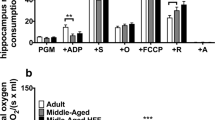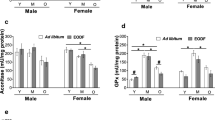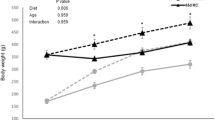Abstract
Previous studies in mammalian models indicate that the rate of mitochondrial reactive oxygen species ROS production and the ensuing modification of mitochondrial DNA (mtDNA) link oxidative stress to aging rate. However, there is scarce information concerning this in relation to caloric restriction (CR) in the brain, an organ of maximum relevance for ageing. Furthermore, it has never been studied if CR started late in life can improve those oxidative stress-related parameters. In this investigation, rats were subjected during 1 year to 40% CR starting at 24 months of age. This protocol of CR significantly decreased the rate of mitochondrial H2O2 production (by 24%) and oxidative damage to mtDNA (by 23%) in the brain below the level of both old and young ad libitum-fed animals. In agreement with the progressive character of aging, the rate of H2O2 production of brain mitochondria stayed constant with age. Oxidative damage to nuclear DNA increased with age and this increase was fully reversed by CR to the level of the young controls. The decrease in ROS production induced by CR was localized at Complex I and occurred without changes in oxygen consumption. Instead, the efficiency of brain mitochondria to avoid electron leak to oxygen at Complex I was increased by CR. The mechanism involved in that increase in efficiency was related to the degree of electronic reduction of the Complex I generator. The results agree with the idea that CR decreases aging rate in part by lowering the rate of free radical generation of mitochondria in the brain.
Similar content being viewed by others
Abbreviations
- dG:
-
deoxyguanosine
- mtDNA:
-
mitochondrial DNA
- nDNA:
-
nuclear DNA
- 8-oxodG:
-
8-oxo,7,8-dihydro-2′-deoxyguanosine
- ROS:
-
reactive oxygen species
References
Asunción, J. G., Millan, A., Pla, R., Bruseghini, I., Esteras, A., Pallardo, F. V., Sastre, J., and Viña, J. (1996). FASEB J. 10, 333–338.
Baek, B. S., Kwon, H. J., Lee, K. H., Yoo, M. A., Kim, K. W., Ikeno, Y., Yu, B. P., and Chung, H. Y. (1999). Arch. Pharm. Res. 22, 361–366.
Barja, G. (1999). J. Bioenerg. Biomembr. 31, 347–366.
Barja, G. (2000). Aging Clin. Exp. Res. 12, 342–355.
Barja, G. (2002). J. Bioenerg. Biomembr. 34, 227–233.
Barja, G. (2004a). Trends Neurosci. 27, 595–600.
Barja, G. (2004b). Biol. Rev. 79, 235–251.
Beal, M. F. (2003). Ann. N.Y. Acad. Sci. 991, 120–131.
Beckman, K. B., and Ames, B. (1998). Physiol. Rev. 78, 547–581.
Cao, S. X., Dhabi, J. M., Mote, P. L., and Spindler, S. R. (2001). PNAS. 98, 10630–10635.
Edwards, M. G., Sarkar, D., Klopp, R., Morrow, J. D., Weindruch, R. D., and Prolla, T. A. (2003). Physiol. Genomics. 13, 119–127.
Forster, M. J., Morris, P., and Sohal, R. S. (2003). FASEB J. 17, 690–692.
Gredilla, R., Sanz, A., López-Torres, M., and Barja, G. (2001). FASEB J. 15, 1589–1591.
Greenberg, J. A., Wei, H., Ward, K., and Boozer, C. N. (2000). Mech. Ageing Dev. 115, 107–117.
Hamilton, M. L., Van Remmen, H. V., Drake, J. A., Yang, H., Guo, Z. M., Kewitt, K., Walter, C. A., and Richardson, A. (2001). PNAS 98, 10469–10474.
Herrero, A., and Barja, G. (2001). J. Am. Aging Assoc. 24, 45–50.
Hoglinger, G. U., Carrad, G., Michel, P. P., Medja, F., Lombes, A., Ruberg, M., Friguet, B., and Hirsch, E. C. (2003). J. Neurochem. 86, 1297–1307.
Honda, K. (2004). Ann. N.Y. Acad. Sci. 1012, 179–182.
Ingram, D. K., Weindruch, R., Spangler, E. L., Freeman, J. R., and Walford, R. L. (1987). J. Gerontol. 42, 78–81.
Kanda, K. (2002). Micros Res. Tech. 59, 301–305.
Kaneko, T., Tahara, S., and Matsuo, M. (1997). Free Radical. Biol. Med. 23, 76–81.
Khrapko, K., Nekhaeva, E., Kraytsberg, Y., and Kunz, W. (2003). Mutat. Res. 522, 13–19.
Lai, C. K., and Clark, J. B. (1979). Methods Enzymol. 55, 51–60.
Latorre, A., Moya, A., and Ayala, A. (1986). PNAS USA 83, 8649–8653.
Lee, C. K., Allison, D. B., Brand, J., Weindruch, R., and Prolla, T. A. (2002). PNAS 99, 14988–14993.
López-Torres, M., Gredilla, R., Sanz, A., and Barja, G. (2002). Free Radical. Biol. Med. 32, 882–889.
Loft, S., and Poulsen, H. E. (1999). Methods Enzymol. 300, 166–184.
Mattson, M. P., Chan, S. L., and Duan, W. (2002). Physiol. Rev. 82, 637–672.
Mattson, M. P. (2003). Neurology 60, 690–695.
Meccoci, P., MacGarvey, U., Kaufman, A. E., Koontz, D., Shoffner, J. M., Wallace, D. C., and Beal, F. (1993). Ann. Neurol. 34, 609–616.
Moroi-Fetters, S. E. (1989). Neurobiol. Aging 10, 317–322.
Sanz, A., Gredilla, R., Pamplona, R., Portero-Otín, M., Vara, E., Tresguerres, J. A. F., and Barja, G. (2005). Biogerontol. 6, 15–26.
Sohal, R. S., Ku, H. H., Agarwal, S., Forster, M. J., and Lal, H. (1994a). Mech. Ageing Dev. 74, 121–133.
Sohal, R. S., Agarwal, S., Candas, M., Forster, M. J., and Lal, H. (1994b). Mech. Ageing Dev. 76, 215–224.
Starkov, A. A., and Fiskum, G. (2003). J. Neurochem. 86, 1101–1107.
Stuart, J. A., Karahalil, B., Hogue, B. A., Souza-Pinto, N. C., and Bohr, V. A. (2004). FASEB J. 18, 595–597.
Takahashi, R., and Goto, S. (2002). Micros Res. Tech. 59, 278–281.
Tyler, D. D. (1992). The Mitochondria in Health and Disease, VCH Publishers, New York.
Wanagat, J., Allison, D. B., and Weindruch, R. (1999). Toxicol. Sci. 52S, 35–40.
Author information
Authors and Affiliations
Corresponding author
Rights and permissions
About this article
Cite this article
Sanz, A., Caro, P., Ibañez, J. et al. Dietary Restriction at Old Age Lowers Mitochondrial Oxygen Radical Production and Leak at Complex I and Oxidative DNA Damage in Rat Brain. J Bioenerg Biomembr 37, 83–90 (2005). https://doi.org/10.1007/s10863-005-4131-0
Received:
Accepted:
Issue Date:
DOI: https://doi.org/10.1007/s10863-005-4131-0




